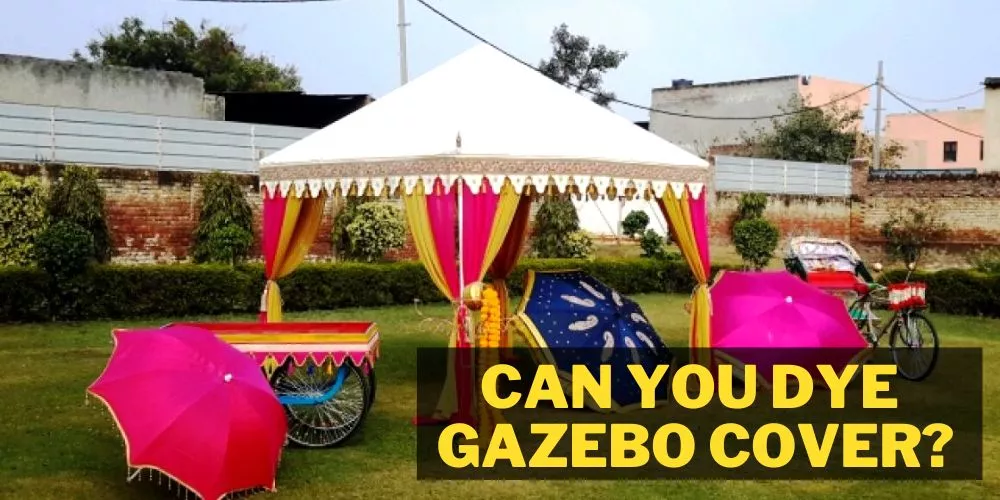In assessing whether a gazebo can withstand heavy rain, it’s essential to consider materials, design, and preventative measures.
Gazebos constructed from durable materials like treated wood, metal, or vinyl, coupled with proper architectural design, can indeed resist heavy rainfall.
Key design elements include a sturdy roof, effective water drainage systems, and robust anchoring to prevent water accumulation and structural instability.
Regular maintenance, such as waterproofing and inspecting for damages, further enhances a gazebo’s resilience against harsh weather.
Can a gazebo withstand heavy rain?
Yes, a well-constructed gazebo can withstand heavy rain. However, the ability to resist rain depends on several factors:
- Material: Gazebos made from durable materials like metal, hardwood, or vinyl have a higher resistance to heavy rain compared to gazebos made from softwood or fabric.
- Roof Type: A solid roof with shingles or metal sheeting will provide better protection from heavy rain than a cloth or canvas roof.
- Waterproofing: Proper sealing and waterproofing of joints, seams, and edges will increase a gazebo’s resistance to heavy rain. Ensure that the gazebo has sufficient drainage to prevent water from accumulating.
- Construction Quality: A well-built gazebo with proper attention to structural integrity, fastening points, and overall design will be better equipped to handle heavy rain.
- Wind Resistance: In addition to heavy rain, strong winds can accompany storms. Ensure your gazebo is anchored securely to the ground and has adequate wind resistance features.
A gazebo can withstand heavy rain if constructed with appropriate materials and designed for weather resistance. Regular maintenance, waterproofing, and proper anchoring are crucial for safeguarding your gazebo against heavy rain and other adverse weather conditions.
Understanding Gazebo Construction and Materials
Understanding the intricacies of gazebo construction and the materials used is the first step towards grasping the resilience of gazebos in heavy rain. We’ll examine the diverse designs, structures, and materials employed and how these elements interact with our central question: Can a gazebo withstand heavy rain?
1. Gazebo Designs and Structures
Regarding gazebos, there are two broad categories based on permanence: permanent gazebos and temporary or portable gazebos.
Permanent gazebos
Permanent gazebos are sturdy structures often built as an extension of the home or as a standalone structure in a garden or yard. Made from robust materials like wood, metal, or vinyl, they are designed to endure various weather conditions, including heavy rain. These gazebos typically feature a solid roof and optional sides and are firmly anchored to the ground, offering maximum protection against weather elements.
Temporary or portable gazebos
On the flip side, we have temporary or portable gazebos. These structures are designed for convenience and mobility, perfect for camping trips or outdoor events. They’re generally made of lightweight materials like aluminum and covered with a water-resistant fabric. While they offer protection against light rain and sun, their ability to weather a heavy downpour will depend on the quality of construction and materials used.
2. Gazebo Materials and Their Resistance to Rain
The material a gazebo is made from significantly impacts its ability to withstand heavy rain. Let’s delve into the most common gazebo materials: wood, metal, and vinyl.
Wood gazebos
Wood gazebos are a classic choice, known for their aesthetic appeal and sturdy construction. However, their resistance to rain varies by the type of wood used.
Cedar
Cedar is a popular choice for gazebos due to its natural resistance to decay and moisture. Its oils and tannins make it naturally water-resistant, which can hold well in rain.
Redwood
Redwood is another strong, durable wood. It contains tannins, making it resistant to moisture and decay but is generally more expensive than other wood types.
Pressure-treated wood
Pressure-treated wood is designed to resist weather-related wear and tear. Chemicals used in the treatment process help it resist moisture, making it a good choice for gazebos in regions with heavy rainfall.
Metal gazebos
Metal gazebos provide a modern, durable alternative to traditional wood gazebos. Let’s discuss two common types: aluminum and steel.
Aluminum
Aluminium is a lightweight yet strong metal, resistant to rust and corrosion. Aluminum gazebos can withstand rain well, but they are lightweight and require firm anchoring to prevent damage in storms or high winds.
Steel
Steel gazebos are incredibly robust and can handle heavy rain without issues. They are heavier than aluminum ones, and if not properly treated, they might be prone to rust over time.
Vinyl gazebos
Vinyl gazebos are a popular choice for their low maintenance and durability. They can handle all types of weather, including heavy rain, without worrying about rust or decay. This makes them an excellent choice for a weatherproof gazebo.
You May Also Find Useful: Best Gazebo For Wind and Rain | Best Gazebo For High Winds
Factors Affecting Gazebo Durability in Heavy Rain
The durability of a gazebo in heavy rain doesn’t depend solely on its design and materials. Several other factors play significant roles, including wind resistance, maintenance and treatment of materials, and proper installation and assembly. To ensure your gazebo can withstand heavy rain, paying attention to these aspects is crucial.
Wind Resistance
In heavy rain, there’s often wind to consider as well. A gazebo’s ability to resist wind can significantly impact its resilience against the weather.
Gazebo design and stability
A well-designed gazebo takes into account aerodynamics to reduce wind resistance. Features like vented canopies and sloped roofs allow wind to flow over the structure instead of getting trapped. Gazebos with a sturdy, stable base and a strong frame (made of wood, metal, or reinforced plastic) can withstand wind forces better, reducing the risk of toppling or structural damage during heavy rain accompanied by a strong wind.
Anchor and fastening systems
A gazebo’s anchor and fastening systems are paramount in ensuring its stability in the wind. For temporary or portable gazebos, weighted bags or stakes can be used. On the other hand, permanent gazebos should be bolted or cemented into the ground for maximum stability. Regular checks on these systems are essential, especially before the rainy season, to ensure they function optimally.
Material Maintenance and Treatment
No matter how resilient the material of your gazebo is, without proper maintenance and treatment, it won’t stand a chance against prolonged exposure to heavy rain.
Sealing or staining wooden gazebos
Wooden gazebos need regular sealing or staining to maintain their water resistance. These treatments provide a protective layer that repels water, preventing it from seeping into the wood grains. Cedar, redwood, and pressure-treated wood can benefit from annual or bi-annual applications of a high-quality sealer or stain.
Rust prevention for metal gazebo
Metal gazebos, particularly steel ones, can be prone to rust if not properly maintained. Regular checks for any signs of rust and application of rust-resistant paint or primer can extend the life of your gazebo and maintain its ability to withstand heavy rain.
Cleaning and maintaining vinyl gazebos
Vinyl gazebos are relatively low maintenance but still need regular cleaning to prevent mold and mildew build-up that can reduce their longevity. Using a mild detergent and soft brush for cleaning, followed by a thorough rinse, will keep your vinyl gazebo fresh and ready for the rainy season.
Proper Installation and Assembly
Even with the best materials and maintenance, a gazebo won’t hold up well in heavy rain if not properly installed and assembled.
Following the manufacturer’s instructions
Every gazebo comes with a set of instructions from the manufacturer. If followed correctly, these instructions ensure the gazebo is assembled so that it can withstand the elements, including heavy rain. Missteps in assembly can lead to structural weaknesses, making the gazebo vulnerable to weather damage.
Securing the gazebo to the ground
Securing the gazebo to the ground is another crucial part of the installation. Whether through anchoring systems for portable gazebos or cement bases for permanent ones, a secured gazebo is far more resilient against heavy rain and wind than one that isn’t properly secured.
Frequently Asked Questions (FAQs)
Can all gazebos withstand heavy rain?
Not all gazebos can withstand heavy rain. The resilience depends on their design, construction material, and how well they are maintained.
Is it necessary to reinforce a gazebo for rain resistance?
Reinforcing a gazebo can enhance its rain resistance, especially if it’s located in a region prone to heavy rainfall or strong winds.
How often should I inspect and maintain my gazebo?
Regular inspection and maintenance every few months are advisable. However, after heavy rain or storms, immediate checks are recommended.
Can a gazebo withstand a thunderstorm?
A well-constructed and properly anchored gazebo can withstand a thunderstorm, but it’s recommended to take extra precautions like removing detachable parts in extreme weather.
How often should I waterproof my gazebo?
Waterproofing should be done at least once a year, ideally before the rainy season starts. For wooden gazebos, resealing may be necessary more often.
Conclusion:
In conclusion, a gazebo’s resilience to heavy rain hinges on its design, construction materials, and maintenance efforts. Selecting the right gazebo with consideration for durability, such as choosing the appropriate roofing and anchoring system, plays a vital role. Regular inspection, maintenance, and necessary reinforcements further enhance rain resistance. We hope that this guide has been helpful. You can read about similar topics here on our website. Check back again soon for more.

